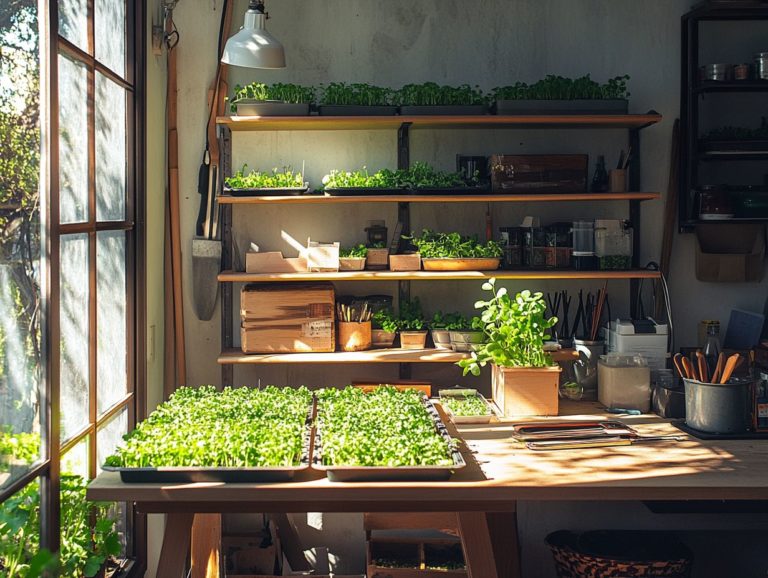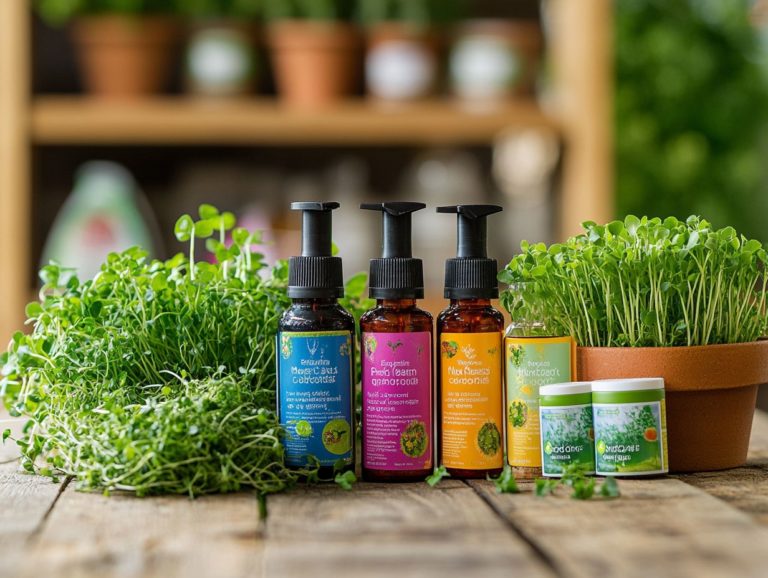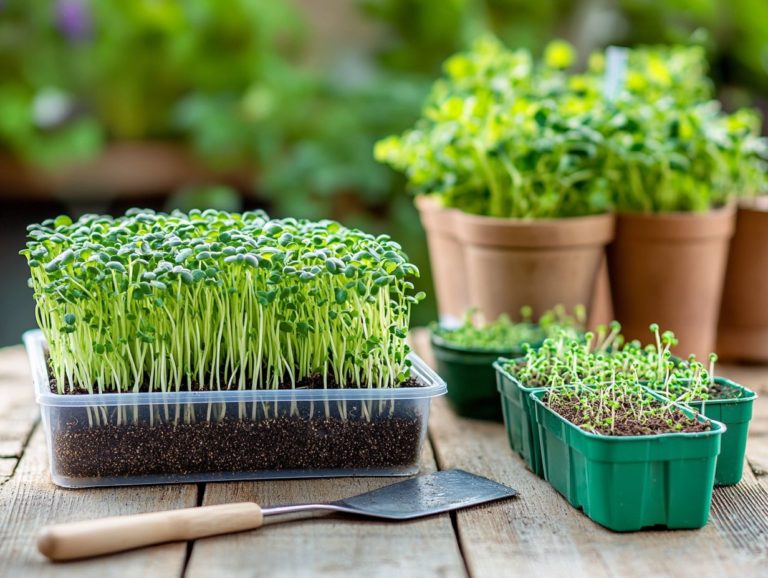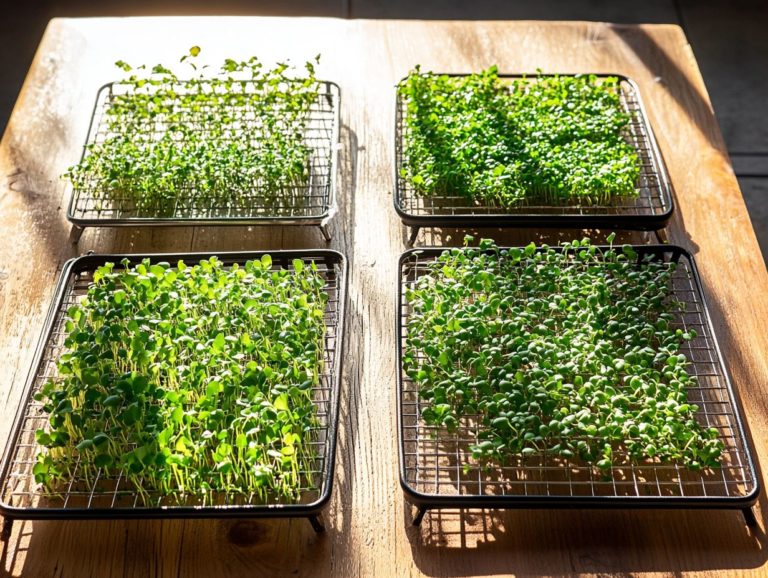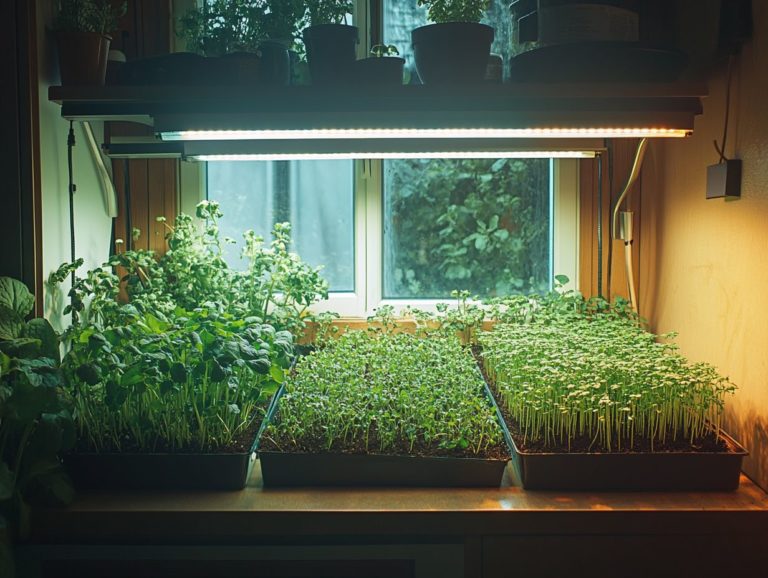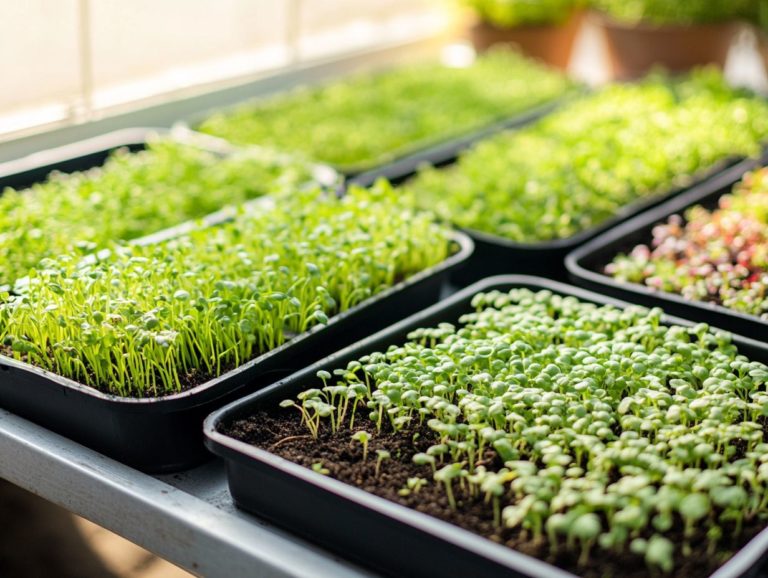How to Enhance Your Microgreen Growing Techniques
Microgreens are those tiny, flavorful gems packed with nutrients and bursting with vibrant colors. They effortlessly elevate any meal and are becoming increasingly popular among health-conscious consumers.
In this article, get ready to uncover the myriad benefits of growing microgreens. You ll learn about their remarkable nutritional value, high yields, and the sheer convenience they bring to your kitchen.
You ll discover how to select the perfect seeds, master effective growing techniques, troubleshoot common challenges, and expertly harvest and utilize your greens, including the best harvest techniques.
Whether you re a seasoned gardener or just dipping your toes into the gardening world, you ll find valuable tips and inspiration to ignite your passion for growing microgreens.
Contents
- Key Takeaways:
- Unlock the Benefits of Growing Microgreens!
- Choosing the Right Seeds for Microgreens
- Techniques for Growing Microgreens
- Troubleshooting Common Issues
- Harvesting and Using Microgreens
- Frequently Asked Questions
- What are microgreens and why are they beneficial for our health?
- How can I enhance my microgreen growing techniques?
- What are some common mistakes to avoid when growing microgreens?
- Can I use any type of seeds for growing microgreens?
- How long does it take for microgreens to grow and be ready for harvest?
- Can I reuse the soil after harvesting my microgreens?
Key Takeaways:
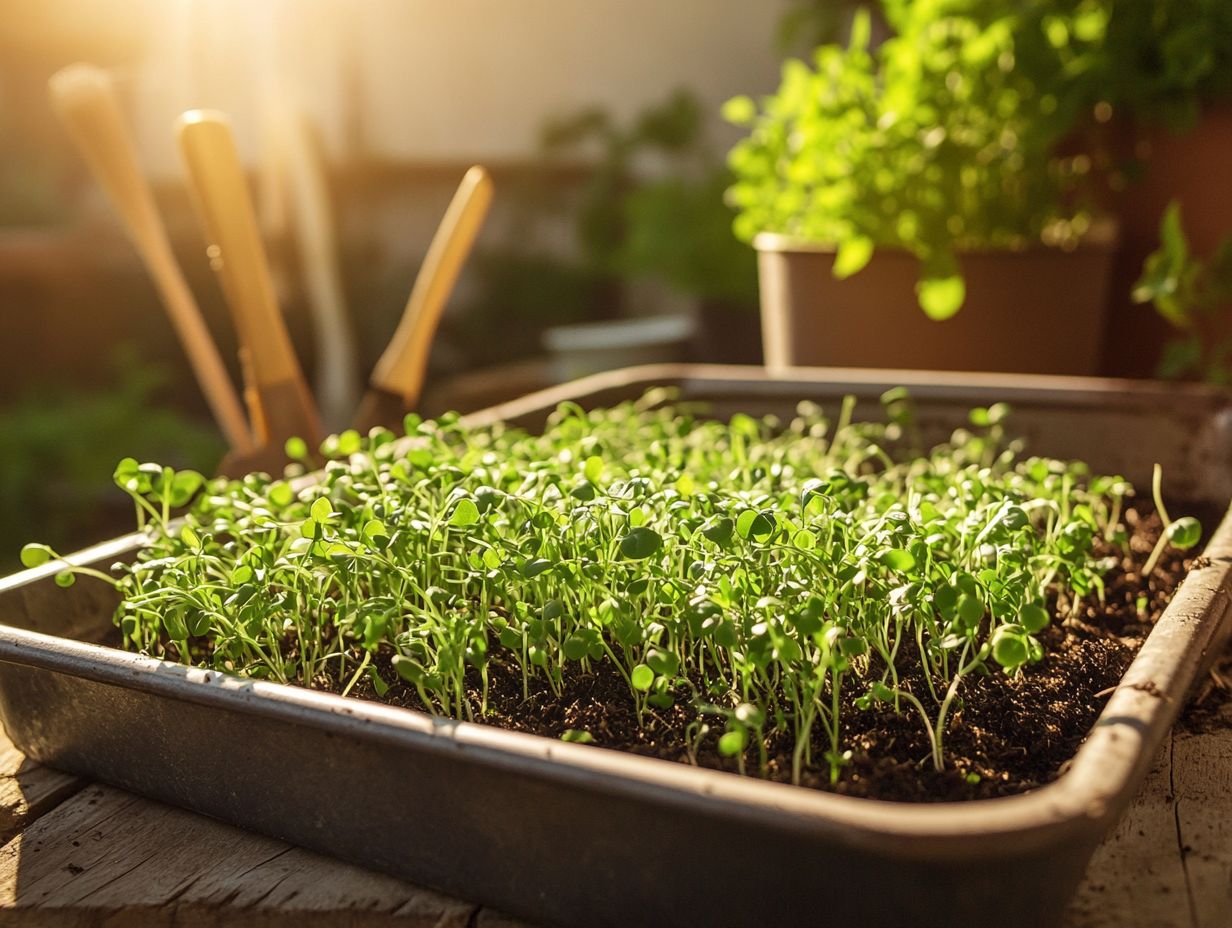
- Start with the right seeds: Choosing high-quality, organic seeds is crucial for successful microgreen farming.
- Master the techniques: From proper watering to pest control, following the right methods ensures healthy greens.
- Experiment with harvest and use: Get creative with microgreens in salads, sandwiches, and even smoothies!
Discover the Power of Microgreens!
Microgreens are those vibrant, young edible plants you can harvest shortly after their first true leaves make an appearance. They burst with a spectrum of colors and flavors and are celebrated for their impressive mineral nutrients and antioxidant properties.
Grown in controlled environments, microgreens present a fantastic opportunity for urban agriculture enthusiasts and advocates of sustainable production alike. Their growing methods, such as growing plants in water instead of soil and growing plants in air with a mist of nutrients, enable efficient use of space and enhanced nutrient management.
These methods make them a perfect fit for urban settings where traditional farming may prove challenging. By embracing these innovative cultivation techniques, you can produce fresh, nutritious greens year-round, even in the most limited of spaces.
The health benefits of microgreens are nothing short of remarkable. They pack concentrated amounts of vitamins, minerals, and phytochemicals, including prebiotic foods that contribute to overall wellness. This aligns perfectly with the increasing demand for healthier food options in our rapidly evolving agricultural landscape.
Unlock the Benefits of Growing Microgreens!
Growing microgreens presents a wealth of benefits, from heightened nutritional value to impressive yields even in confined spaces. These nutrient-dense crops are not only quick to harvest but also adaptable to a variety of growing conditions, making them perfect for urban agriculture and sustainable production efforts.
The remarkable health benefits linked to microgreens include high levels of antioxidants and essential vitamins, and their high mineral content positions them as an invaluable enhancement to any plant-based diet.
Nutritional Value and Convenience
Microgreens are truly remarkable for their exceptional nutritional value, often packed with concentrated levels of essential vitamins, minerals, and antioxidants. These tiny powerhouses are easy to grow and offer significant health benefits, including support for gut health through their prebiotic properties.
With their impressive yields, it s no wonder they are a favorite among urban farmers and health-conscious consumers alike. Beyond their nutrient density, microgreens thrive in a variety of growing conditions, adding to their charm.
Whether cultivated indoors or outdoors, they require minimal space and resources, making them accessible for anyone. Their vibrant colors and diverse flavors not only enhance the visual appeal of your dishes but also signal their rich antioxidant content, which is vital in combating oxidative stress in the body.
Regularly incorporating these versatile greens into your meals can help boost your immune system and promote overall well-being, establishing them as an essential component of any modern diet.
Choosing the Right Seeds for Microgreens
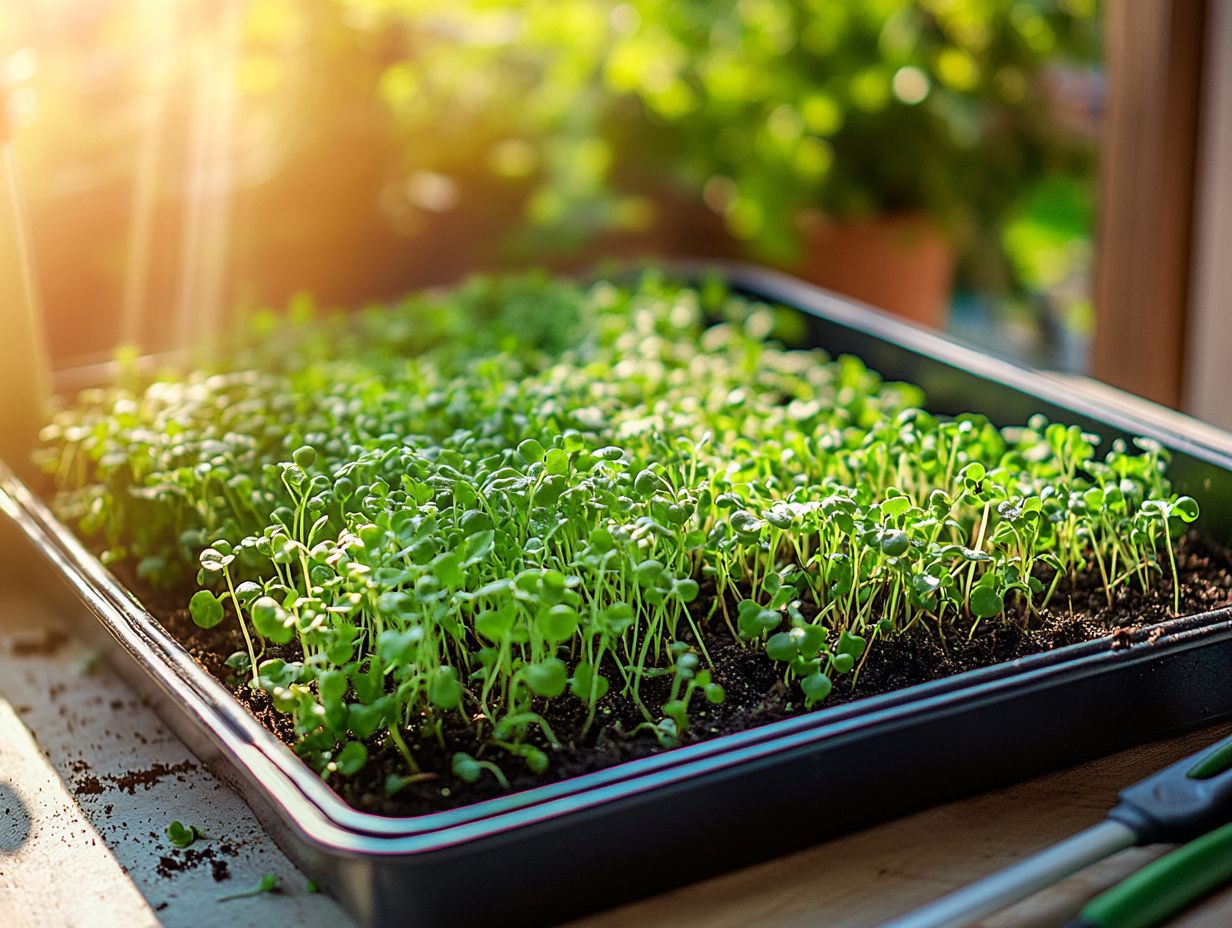
Choosing the right seeds is essential for your success in microgreen farming. Each variety presents its own unique flavors, textures, and growth rates.
Understanding seed density influences the yield and quality of your microgreens. This knowledge helps you use resources effectively and improve crop quality.
Incorporating practices like seed soaking can further boost germination rates. This ultimately leads to healthier, more vibrant plants that thrive in varied growing conditions.
Types of Seeds and Varieties
You ll discover a delightful array of seeds and varieties available for microgreen crops. Each offers a unique flavor and texture that enhances your dining experience.
Popular choices like broccoli sprouts stand out. They are celebrated for their impressive sulforaphane content, alongside other nutrient-dense options that thrive in controlled environment agriculture systems.
When selecting seeds, choose organic nutrients for optimal growth and impressive yields. Pairing these with nutrient management techniques ensures success.
Beyond broccoli, consider varieties such as radish and pea shoots. These bring distinct tastes and remarkable nutrient profiles to your table, contributing to your overall health.
These seedlings are simple to cultivate and require minimal space, making them perfect for both home gardeners and commercial growers.
Maintain a controlled environment to achieve superior results. Showcase vibrant colors and maximize mineral content. Each microgreen variety offers a fantastic opportunity to infuse nutrient-rich solutions into your meals. Elevate both flavor and wellness to new heights.
Techniques for Growing Microgreens
Mastering the techniques for growing microgreens is crucial for achieving optimal results. Control the climate to ensure a healthy crop establishment.
Employing methods such as hydroponic systems (growing plants in water without soil) and aeroponic systems (growing plants in air or mist) can enhance growth rates. These methods provide precise control over moisture levels and nutrient delivery.
By implementing effective growing techniques, you ll significantly improve both yield and quality, contributing to the success of your farms.
Step-by-Step Guide
Growing microgreens is an art that unfolds in essential stages. It starts with selecting the perfect seeds and maintaining optimal growing conditions throughout the journey.
Implement effective nutrient management and automatic irrigation to streamline the entire growing experience. Adding composting methods enriches your growing media, resulting in potent, nutrient-dense crops.
Every vital stage calls for specific gardening tools and techniques to ensure your success. Monitoring moisture levels is crucial, as microgreens thrive in consistently damp environments without becoming waterlogged.
Learn about the lifecycle of beneficial insects to create a balanced ecosystem. This helps repel pests and promotes healthy growth.
By focusing on fundamental elements seed selection, nutrient enrichment, proper irrigation, and pest management you can cultivate lush microgreens that are flavorful and packed with nutrients. Elevate your culinary creations to new heights.
Troubleshooting Common Issues
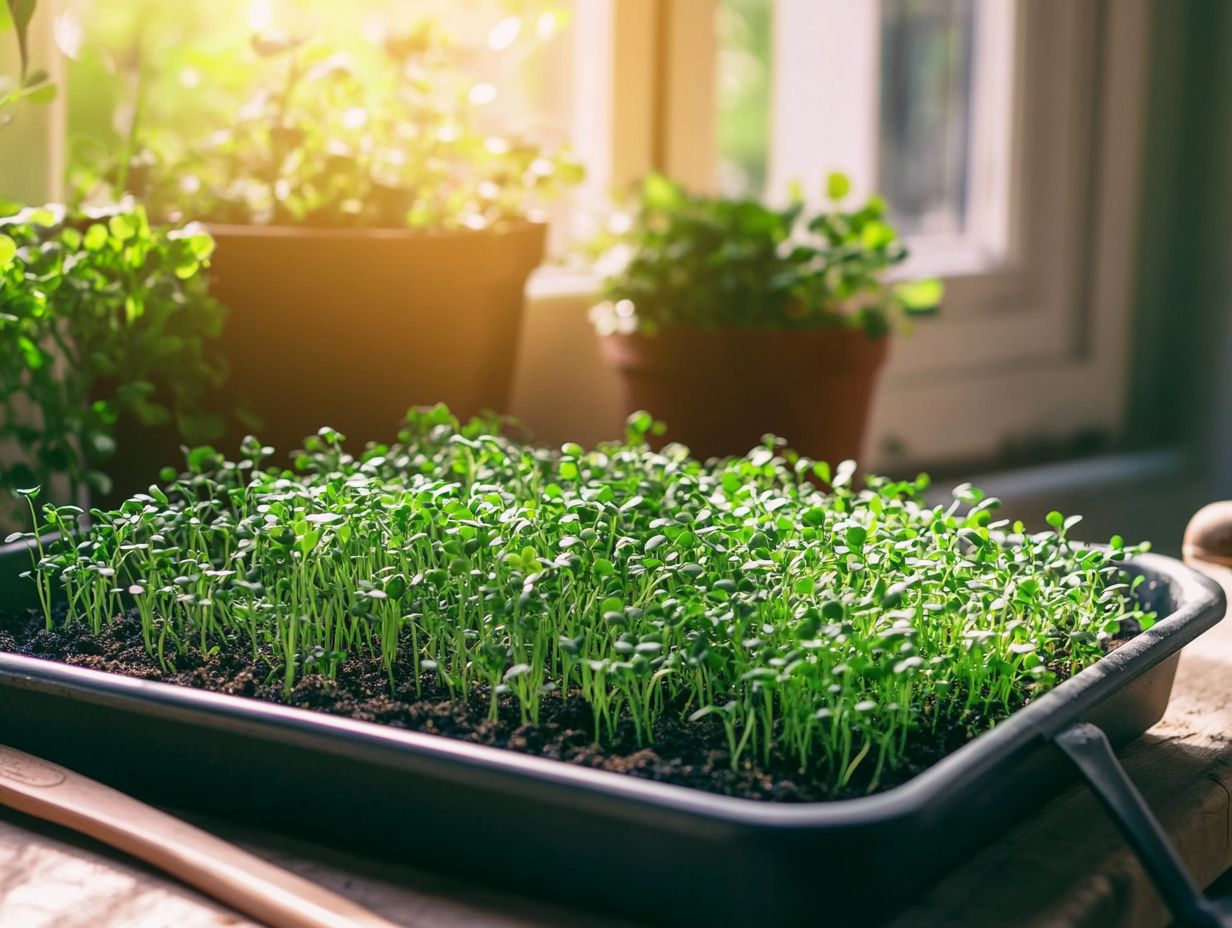
Troubleshooting common issues in microgreen farming is essential for preserving crop quality and securing a successful harvest. Identify problems early, whether it’s pests or insufficient moisture levels.
Take charge by using integrated pest management strategies to keep your microgreens thriving. By taking a proactive approach to these challenges, you can effectively safeguard your yields and ensure your farming efforts flourish under the perfect light conditions for microgreens.
Identifying and Addressing Problems
Identifying and addressing issues in microgreen farming requires your careful watching and timely intervention. This ensures the health of your plants. Consider introducing beneficial insects to tackle any pest problems. Good ways to manage nutrients can significantly enhance both crop quality and overall yield. By proactively managing these elements, you can create an environment where your microgreen crops truly thrive.
To further elevate your microgreen cultivation success, it’s crucial to recognize the signs of nutrient deficiencies. These may reveal themselves through discoloration or stunted growth. Regular soil and water testing will provide valuable insights into nutrient levels. This guides your application of organic fertilizers that encourage robust development. For more tips on maximizing your space, check out this guide on how to grow microgreens in a small space.
Opting for a well-balanced growing media made from sustainable materials will optimize root health and moisture retention. Incorporating integrated pest management practices such as companion planting (growing different plants together for mutual benefits) and natural deterrents (substances that repel pests) helps maintain a healthy ecosystem. This minimizes the need for chemical interventions while fostering resilience in your crops.
Harvesting and Using Microgreens
Harvesting microgreens at the optimal moment is essential for maximizing their flavors and health benefits. This ensures you enjoy the crops at their peak, aligning with sustainable production practices.
Depending on the varieties you’re cultivating, different harvesting techniques can be applied. This grants you the flexibility to incorporate these nutrient-rich greens into an array of culinary creations.
Tips for Harvesting and Recipes to Try
Harvesting microgreens demands precision and care. This ensures these tender plants stay healthy and bursting with flavor, enhancing their culinary allure. By incorporating microgreens into various recipes, you’re not only elevating the dish’s visual appeal but also reaping substantial health benefits thanks to their impressive nutrient profile.
In terms of harvesting these delicate greens, wielding sharp scissors is essential. A swift cut just above the soil line helps prevent damage to the roots, paving the way for potential regrowth.
Once you’ve harvested them, think about adding microgreens to your salads for that delightful crunch. You can also blend them into smoothies for an extra nutrient kick or use them as a colorful garnish on soups and main dishes. Their vibrant hues and distinctive flavors can transform simple meals like avocado toast or omelets, all while boosting the overall nutritional value.
They re truly a perfect addition to any health-conscious kitchen!
Frequently Asked Questions

What are microgreens and why are they beneficial for our health?
Microgreens are young vegetable greens that are harvested just after sprouting. They are packed with essential nutrients, including vitamins, minerals, and antioxidants, making them a great addition to any diet.
How can I enhance my microgreen growing techniques?
There are several ways to enhance your microgreen growing techniques. These include choosing the right seeds, using high-quality soil, providing proper lighting and ventilation, and watering consistently.
What are some common mistakes to avoid when growing microgreens?
Some common mistakes to avoid when growing microgreens include overcrowding the seeds, using poor quality soil, over or under-watering, and not providing enough light or ventilation.
Can I use any type of seeds for growing microgreens?
While you can technically use any type of seeds for growing microgreens, it is best to use seeds specifically labeled for microgreens. These will have a higher success rate and be more nutrient-dense.
How long does it take for microgreens to grow and be ready for harvest?
The time it takes for microgreens to grow and be ready for harvest can vary depending on the type of seed. On average, it takes about 1-3 weeks. You can harvest them when the first set of true leaves appear.
Can I reuse the soil after harvesting my microgreens?
Yes, you can reuse the soil after harvesting your microgreens. However, it is important to replenish the nutrients by adding compost or fertilizer before planting new seeds. It is also recommended to rotate the soil to prevent any potential diseases or pests.
Start your microgreen journey today and enjoy fresh greens right from your kitchen!

